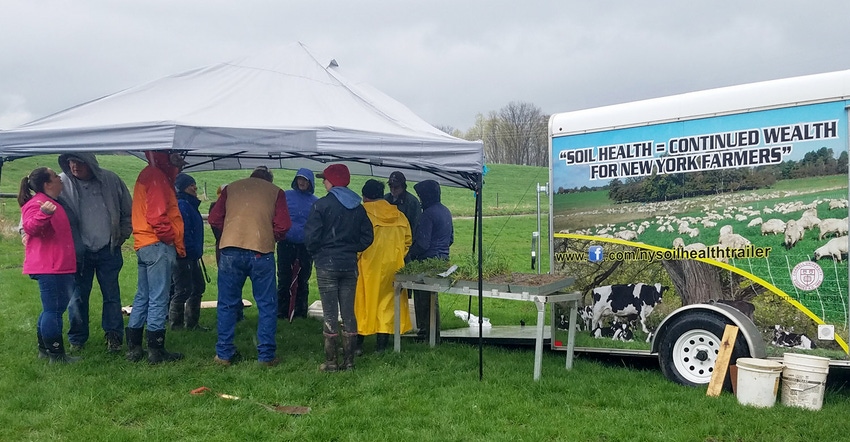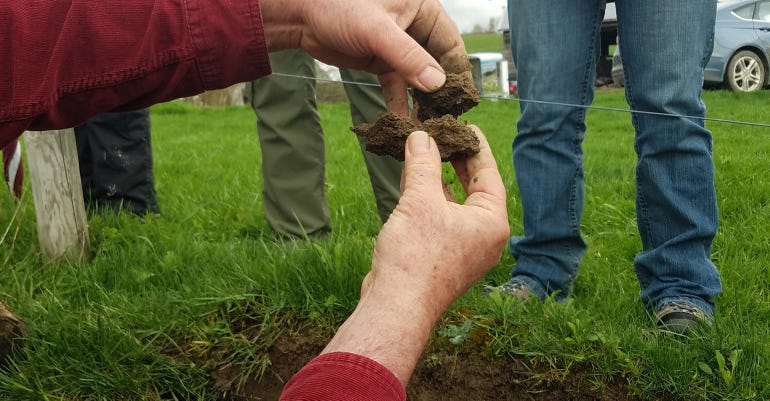June 5, 2019

By Diane Frances
The New York Soil Health Trailer brought Train the Trainer programs to Brunswick and Troupsburg, N.Y.
The programs were taught by Fay Benson, coordinator of the New York Soil Health Trainer and soil Extension specialist; Larry Hepner, soil structure consultant; and Bob Schindelbeck, director of the Cornell Soil Health Laboratory.
Seventeen grazing educators attended the two trainings, offered as the first part of a Northeast Sustainable Agriculture Research & Education (SARE) project to educate and provide research on soil compaction in Northeast pastures.
The trailer will be traveling across the Northeast, participating in pasture walks and other events this summer and fall. Scheduled events include Grasstravaganza from July 25-27 in Cobleskill; Empire Farm Days from Aug. 6-8 in Seneca Falls; the Great New York State Fair in Syracuse; and Maine Soil Field Days from Sept. 3-6.
Compaction is an important issue in agriculture that affects soil health and productivity. Compacted soils, which result from heavy tractor and animal use over time, have less water and air flow and are therefore less productive. Identifying compaction is the first step toward remediation.
Compaction tools
Benson is working with farmers and ag educators to develop tools to improve pasture management.
His idea for this SARE project is to use a soil penetrometer to measure soil penetration resistance in the fence line of a pasture where no livestock compaction has occurred and within the grazing area where compaction is likely. The goal is to develop tools to help farmers better identify areas of compaction and how to deal with it.
Understanding the soil
Hepner, a consulting agronomist and retired Delaware Valley University professor of agronomy and environmental science, spoke at the training sessions on how to describe soil structure based on USDA-NRCS terminology.
Structure is how the sand, silt and clay fit together to form aggregates. It is described using terms for type, grade and class. Typically, surface soil layers have granular structure that is very good for infiltration, water movement, and oxygen and carbon dioxide exchange. Granular structure usually produces maximum growth of plants.
When compaction occurs, the granules are crushed and converted to plates. Platy structures impede water movement, stay wet longer, and have poor oxygen and carbon dioxide exchange, resulting in less plant growth.
Testing for compaction
While compaction in fields is difficult to avoid, a healthy soil can be much more resilient when it comes to compaction. Through field research, correlating penetrometer readings and moisture levels, Benson is working to develop ways that farmers and ag educators can better identify soil compaction any time of year, and then take appropriate action to address it.
 FINDING THE PLATES: Consulting agronomist Larry Hepner shows how to identify platy structure in pasture soil. When plates form, they can restrict roots, water and air from lower depths of the soil.
FINDING THE PLATES: Consulting agronomist Larry Hepner shows how to identify platy structure in pasture soil. When plates form, they can restrict roots, water and air from lower depths of the soil.

He suggests grazers test their pasture soil compaction level by using a step-in post, pushing the post into the soil up to 6 inches repeatedly — first in the pasture, then under the fence line.
If there is a significant difference, then soil compaction is likely happening.
Benson says it is best if the soil moisture level is at relatively normal condition for testing, not overly saturated.
Frances is a fabric artist, farmer and blogger in Harpersfield, N.Y.
You May Also Like




